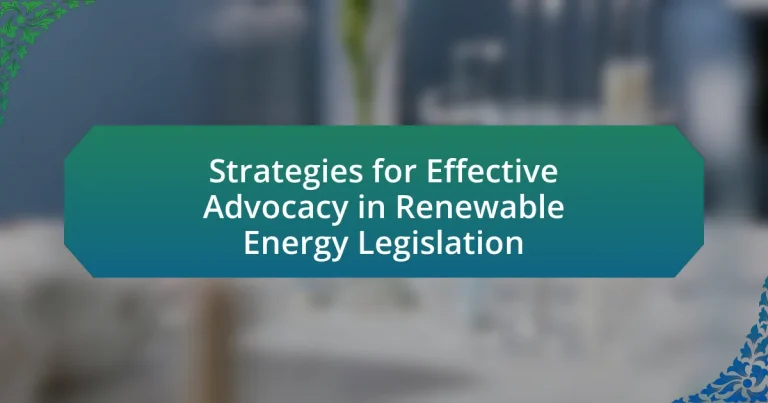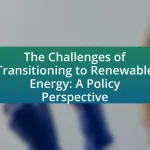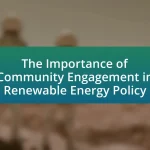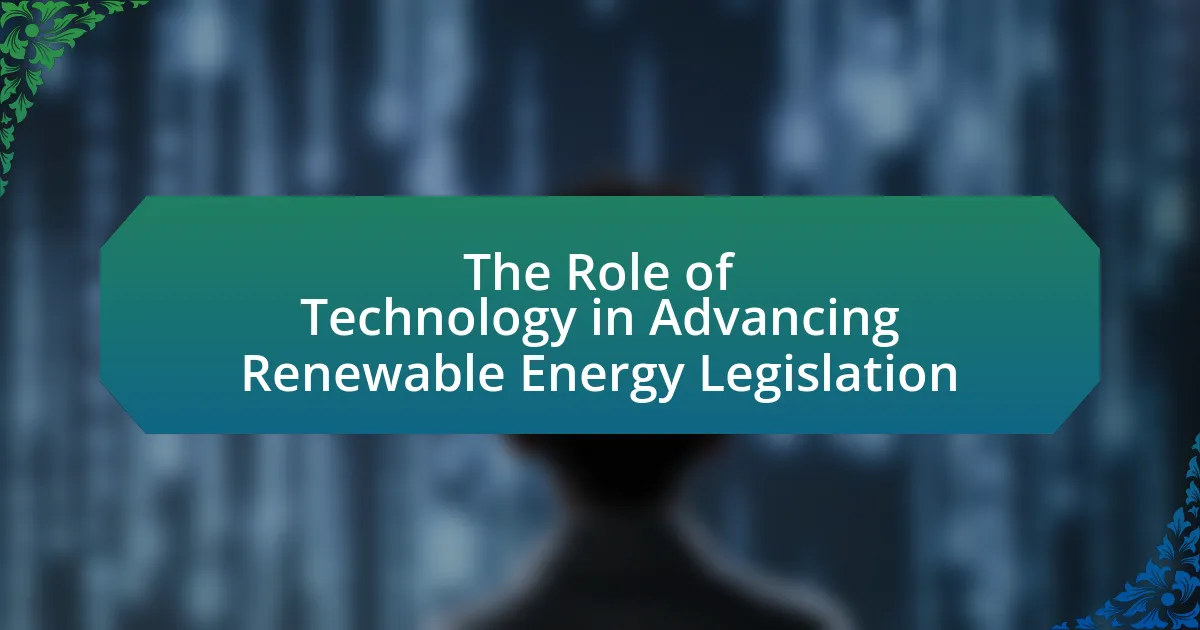The article focuses on strategies for effective advocacy in renewable energy legislation, emphasizing the importance of building coalitions, engaging stakeholders, and utilizing data-driven arguments. Key strategies include identifying advocacy goals through legislative analysis, understanding the legislative process, and employing effective communication techniques tailored to different audiences. The article also addresses challenges faced in advocacy, such as political opposition and misinformation, while providing practical tips for grassroots mobilization and measuring advocacy success. Overall, it highlights the critical role of collaboration and informed strategies in promoting renewable energy initiatives.
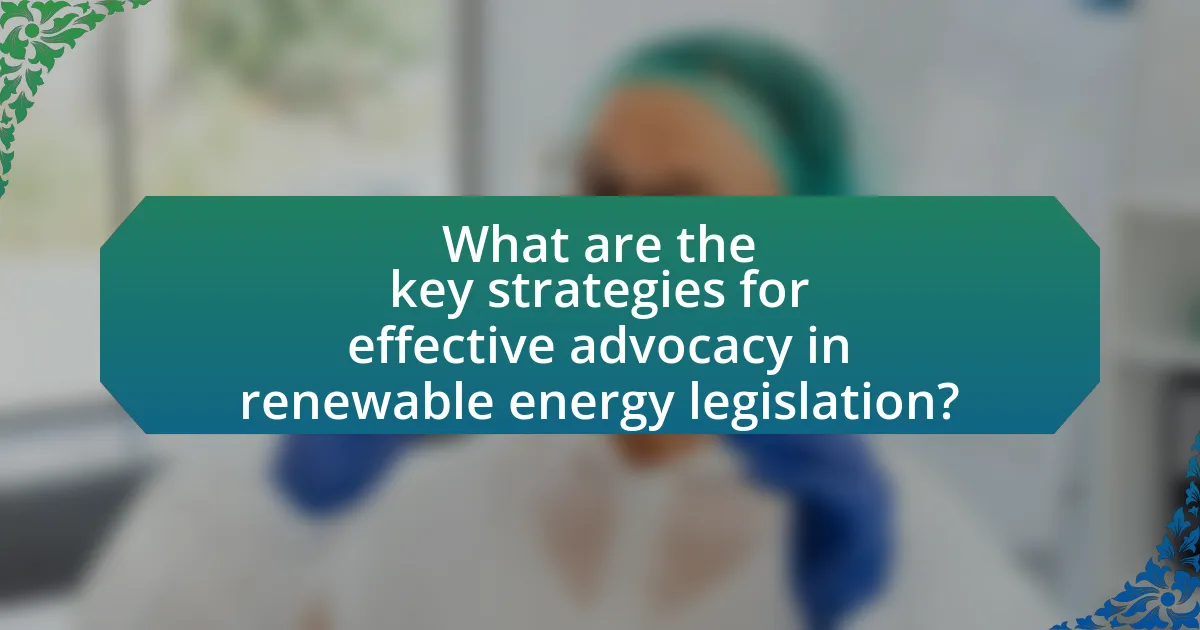
What are the key strategies for effective advocacy in renewable energy legislation?
Key strategies for effective advocacy in renewable energy legislation include building coalitions, engaging stakeholders, utilizing data-driven arguments, and leveraging social media. Building coalitions with diverse groups enhances credibility and broadens support, as seen in successful campaigns like the Clean Power Plan, which united environmental organizations and business leaders. Engaging stakeholders, including local communities and policymakers, ensures that advocacy efforts address specific needs and concerns, fostering a sense of ownership and collaboration. Utilizing data-driven arguments, such as presenting statistics on job creation and economic benefits from renewable energy, strengthens the case for legislation; for instance, a report by the International Renewable Energy Agency highlighted that renewable energy jobs could reach 24 million globally by 2030. Leveraging social media platforms amplifies advocacy messages and mobilizes grassroots support, as demonstrated by campaigns that effectively used Twitter and Facebook to influence public opinion and legislative outcomes.
How can stakeholders identify their advocacy goals in renewable energy legislation?
Stakeholders can identify their advocacy goals in renewable energy legislation by conducting a thorough analysis of the current legislative landscape and aligning their objectives with specific policy gaps or opportunities. This involves assessing existing laws, regulations, and proposed bills to pinpoint areas where advocacy can lead to meaningful change, such as promoting renewable energy incentives or addressing barriers to implementation.
For instance, stakeholders can utilize data from organizations like the International Renewable Energy Agency, which provides insights on renewable energy trends and policy effectiveness, to inform their goals. Additionally, engaging with community members and industry experts can help stakeholders understand local needs and priorities, ensuring that their advocacy efforts are relevant and impactful.
What factors should be considered when setting advocacy objectives?
When setting advocacy objectives, it is essential to consider the target audience, the specific issues at stake, the desired outcomes, and the available resources. The target audience influences the messaging and approach, ensuring that the advocacy resonates with those who can effect change. The specific issues at stake must be clearly defined to focus efforts effectively, while the desired outcomes should be realistic and measurable to assess progress. Additionally, available resources, including time, funding, and personnel, determine the feasibility of achieving the objectives. These factors collectively guide the development of a strategic advocacy plan that aligns with the goals of promoting renewable energy legislation.
How do specific goals influence advocacy strategies?
Specific goals significantly influence advocacy strategies by determining the focus, messaging, and tactics employed in campaigns. For instance, if the goal is to increase public awareness about renewable energy benefits, advocacy strategies may include educational campaigns, community workshops, and social media outreach to engage the public effectively. Conversely, if the goal is to influence legislative change, strategies might shift towards lobbying efforts, coalition-building with stakeholders, and direct engagement with policymakers to ensure that specific legislative proposals are supported. Research indicates that advocacy efforts aligned with clear, measurable goals are more likely to achieve desired outcomes, as evidenced by successful campaigns that have led to significant policy changes in renewable energy legislation, such as California’s Renewable Portfolio Standard, which was influenced by targeted advocacy efforts aimed at specific legislative objectives.
Why is understanding the legislative process crucial for advocacy?
Understanding the legislative process is crucial for advocacy because it enables advocates to effectively influence policy decisions and navigate the complexities of lawmaking. By comprehending how legislation is proposed, debated, and enacted, advocates can identify key stakeholders, timing, and strategies to promote their causes. For instance, knowledge of committee structures and voting procedures allows advocates to target their efforts where they will be most impactful, increasing the likelihood of successful outcomes in renewable energy legislation.
What are the main stages of the legislative process relevant to renewable energy?
The main stages of the legislative process relevant to renewable energy include proposal, committee review, floor debate, voting, and presidential approval. Initially, a renewable energy bill is proposed, often by a member of Congress or a senator. This proposal is then assigned to a committee that specializes in energy or environmental issues, where it undergoes detailed examination and possible amendments. Following committee approval, the bill is brought to the floor of the legislative body for debate, allowing members to discuss its merits and suggest further changes. After debate, the bill is put to a vote; if it passes, it moves to the other legislative chamber for a similar process. Finally, if both chambers approve the bill, it is sent to the president for approval or veto. This structured process ensures thorough consideration of renewable energy legislation, reflecting its importance in addressing energy policy and environmental concerns.
How can advocates navigate the legislative process effectively?
Advocates can navigate the legislative process effectively by building strong relationships with lawmakers and understanding the legislative calendar. Establishing connections with legislators allows advocates to communicate their priorities and influence policy decisions. Additionally, being aware of key dates, such as committee meetings and voting schedules, enables advocates to time their outreach and advocacy efforts strategically. Research shows that personal interactions with legislators significantly increase the likelihood of policy support, as highlighted in a study by the National Conference of State Legislatures, which found that direct engagement leads to more favorable legislative outcomes.
What role do coalitions play in renewable energy advocacy?
Coalitions play a crucial role in renewable energy advocacy by uniting diverse stakeholders to amplify their collective voice and influence policy decisions. These alliances, which often include non-profit organizations, businesses, and community groups, enhance advocacy efforts by pooling resources, sharing expertise, and coordinating strategies. For instance, coalitions like the Renewable Energy Buyers Alliance have successfully lobbied for favorable legislation and market conditions that support renewable energy deployment, demonstrating the effectiveness of collaborative advocacy in achieving common goals.
How can forming coalitions enhance advocacy efforts?
Forming coalitions enhances advocacy efforts by uniting diverse stakeholders to amplify their collective voice and influence. When organizations collaborate, they can pool resources, share expertise, and broaden their reach, making their advocacy campaigns more effective. For instance, coalitions can leverage the combined membership and networks of various groups to mobilize larger audiences and attract media attention, which is crucial in shaping public opinion and policy decisions. Research shows that coalitions in environmental advocacy have led to significant legislative changes, such as the passage of the Clean Air Act, demonstrating the power of unified efforts in achieving common goals.
What are the best practices for building effective coalitions?
The best practices for building effective coalitions include establishing clear goals, fostering open communication, and ensuring diverse representation. Clear goals align coalition members on shared objectives, which enhances focus and commitment. Open communication facilitates trust and collaboration, allowing members to share insights and address challenges effectively. Diverse representation brings varied perspectives and expertise, enriching the coalition’s approach and increasing its credibility. Research indicates that coalitions with diverse membership are more successful in achieving their objectives, as they can mobilize broader support and resources.
How can effective communication strategies improve advocacy outcomes?
Effective communication strategies can significantly enhance advocacy outcomes by ensuring that messages are clear, persuasive, and tailored to the target audience. When advocates utilize strategies such as storytelling, data visualization, and audience segmentation, they can effectively convey the importance of renewable energy legislation, thereby increasing public support and influencing policymakers. Research indicates that campaigns employing targeted messaging can achieve up to 50% higher engagement rates compared to generic approaches, demonstrating the impact of effective communication on advocacy success.
What messaging techniques resonate best with policymakers?
Messaging techniques that resonate best with policymakers include data-driven narratives, personal stories, and clear calls to action. Data-driven narratives provide evidence and statistics that support the proposed policies, making the argument more compelling; for instance, studies show that renewable energy can create jobs and reduce costs, which appeals to economic interests. Personal stories humanize the issue, allowing policymakers to connect emotionally with constituents affected by energy policies. Clear calls to action outline specific steps policymakers can take, making it easier for them to support the initiative. These techniques are effective because they align with policymakers’ need for credible information, emotional engagement, and actionable solutions.
How can advocates tailor their communication to different audiences?
Advocates can tailor their communication to different audiences by adjusting their messaging, tone, and delivery methods based on the audience’s values, knowledge level, and interests. For instance, when addressing policymakers, advocates should use data-driven arguments and emphasize economic benefits, as studies show that legislators respond positively to evidence-based information. Conversely, when communicating with the general public, advocates might focus on storytelling and emotional appeals to connect on a personal level, as research indicates that narratives can enhance engagement and understanding. Additionally, utilizing various platforms—such as social media for younger audiences and traditional media for older demographics—ensures that the message reaches the intended audience effectively.
What are the challenges faced in advocating for renewable energy legislation?
Advocating for renewable energy legislation faces several challenges, including political opposition, economic interests, and public awareness. Political opposition often arises from lawmakers aligned with fossil fuel industries, which can hinder the passage of supportive legislation. Economic interests also play a significant role, as established energy companies may resist changes that threaten their profitability; for instance, in 2020, the fossil fuel industry spent over $100 million on lobbying efforts in the United States alone. Additionally, public awareness and understanding of renewable energy benefits are often limited, making it difficult to garner widespread support for legislative initiatives. These challenges collectively impede the advancement of effective renewable energy policies.
How can advocates overcome opposition from traditional energy sectors?
Advocates can overcome opposition from traditional energy sectors by employing strategic communication and coalition-building. Effective communication involves clearly articulating the benefits of renewable energy, such as job creation and environmental sustainability, which can resonate with both the public and policymakers. For instance, a study by the International Renewable Energy Agency (IRENA) found that transitioning to renewable energy could create 24 million jobs globally by 2030, highlighting the economic advantages.
Additionally, forming coalitions with diverse stakeholders, including businesses, environmental groups, and community organizations, can amplify advocates’ voices and demonstrate broad support for renewable initiatives. Research from the Pew Charitable Trusts indicates that collaborative efforts can lead to more effective policy outcomes, as they present a united front against traditional energy interests. By leveraging data and building alliances, advocates can effectively counter opposition and promote renewable energy legislation.
What strategies can be employed to address misinformation about renewable energy?
To address misinformation about renewable energy, strategies such as promoting transparency, utilizing fact-checking resources, and engaging in community education can be employed. Promoting transparency involves providing clear, accessible information about renewable energy technologies and their benefits, which can counteract false narratives. Utilizing fact-checking resources, like the International Renewable Energy Agency’s reports, helps to verify claims and dispel myths. Engaging in community education through workshops and outreach programs fosters informed discussions, allowing individuals to critically assess information and make evidence-based decisions. These strategies collectively enhance public understanding and trust in renewable energy initiatives.
How can data and research support advocacy efforts?
Data and research can significantly enhance advocacy efforts by providing evidence-based support for claims and policy recommendations. For instance, studies demonstrating the economic benefits of renewable energy, such as the report by the International Renewable Energy Agency, show that transitioning to renewable sources can create millions of jobs and stimulate economic growth. This data empowers advocates to present compelling arguments to policymakers, thereby increasing the likelihood of legislative support. Additionally, research on public opinion trends can help tailor advocacy messages to resonate with constituents, making campaigns more effective.
What types of data are most persuasive in renewable energy advocacy?
Quantitative data, such as cost savings, job creation statistics, and emissions reductions, are the most persuasive in renewable energy advocacy. For instance, studies show that transitioning to renewable energy can save consumers up to $1.2 trillion by 2030 due to lower energy costs and reduced health expenses associated with pollution. Additionally, the U.S. Bureau of Labor Statistics projects that jobs in the renewable energy sector will grow by 11% from 2018 to 2028, significantly outpacing the average job growth rate. Furthermore, data indicating that renewable energy sources can reduce greenhouse gas emissions by up to 70% compared to fossil fuels strengthens the argument for their adoption. These concrete figures provide compelling evidence that supports the case for renewable energy initiatives.
How can advocates effectively present research findings to policymakers?
Advocates can effectively present research findings to policymakers by tailoring the information to align with the policymakers’ priorities and using clear, concise language. This approach ensures that the findings are relevant and easily understood, which increases the likelihood of influencing decision-making. For instance, studies show that when advocates use data visualizations, such as graphs and charts, they enhance comprehension and retention of complex information, making it more accessible for policymakers. Additionally, presenting case studies that demonstrate successful implementation of similar policies can provide concrete examples that resonate with policymakers, thereby reinforcing the validity of the research findings.
What are the best practices for grassroots mobilization in renewable energy advocacy?
The best practices for grassroots mobilization in renewable energy advocacy include building a strong community network, leveraging social media for outreach, and engaging in local events to raise awareness. A strong community network fosters collaboration and shared goals, which is essential for effective advocacy. Utilizing social media platforms allows advocates to reach a wider audience quickly; for instance, campaigns that use targeted messaging on platforms like Facebook and Twitter have shown increased engagement and participation. Additionally, participating in local events, such as town hall meetings or community fairs, helps to educate the public and gather support, as evidenced by the success of initiatives like the Solarize campaign, which mobilized communities to adopt solar energy collectively.
How can advocates engage the public to support renewable energy initiatives?
Advocates can engage the public to support renewable energy initiatives by utilizing targeted communication strategies that emphasize the benefits of renewable energy. For instance, they can organize community events that showcase renewable technologies, such as solar panels or wind turbines, allowing the public to experience these innovations firsthand. Research indicates that personal engagement increases public support; a study by the National Renewable Energy Laboratory found that communities with direct exposure to renewable projects are 50% more likely to support such initiatives. Additionally, advocates can leverage social media campaigns to disseminate informative content, highlighting economic benefits, job creation, and environmental impacts, thus fostering a sense of urgency and collective action among the public.
What tools and platforms are effective for grassroots organizing?
Effective tools and platforms for grassroots organizing include social media networks, email marketing services, and community organizing software. Social media platforms like Facebook and Twitter facilitate outreach and engagement, allowing organizers to mobilize supporters quickly and share information widely. Email marketing services such as Mailchimp enable targeted communication with supporters, helping to keep them informed and engaged. Community organizing software like Action Network provides tools for managing campaigns, tracking volunteer efforts, and organizing events, which enhances coordination and effectiveness. These tools have been proven to increase participation and streamline communication in grassroots movements, particularly in the context of advocacy for renewable energy legislation.
How can advocates measure the success of their advocacy efforts?
Advocates can measure the success of their advocacy efforts through specific metrics such as policy changes, stakeholder engagement, and public awareness levels. For instance, tracking the number of legislative bills passed or amended as a direct result of advocacy campaigns provides concrete evidence of influence. Additionally, surveys assessing changes in public opinion or awareness regarding renewable energy issues can quantify the impact of advocacy initiatives. Data from organizations like the Renewable Energy Policy Network indicates that successful advocacy can lead to a measurable increase in renewable energy adoption rates, further validating the effectiveness of these efforts.
What metrics should be used to evaluate advocacy effectiveness?
To evaluate advocacy effectiveness, key metrics include policy changes achieved, stakeholder engagement levels, and public awareness shifts. Policy changes reflect the direct impact of advocacy efforts, as evidenced by the passage of legislation or amendments that align with advocacy goals. Stakeholder engagement levels can be measured through participation rates in advocacy events, feedback from targeted groups, and coalition-building success, indicating the breadth of influence and support. Public awareness shifts can be assessed through surveys measuring changes in public opinion or knowledge regarding renewable energy issues, demonstrating the effectiveness of communication strategies. These metrics collectively provide a comprehensive view of advocacy effectiveness in the context of renewable energy legislation.
How can feedback be incorporated to improve future advocacy strategies?
Feedback can be incorporated to improve future advocacy strategies by systematically collecting and analyzing input from stakeholders, including community members, policymakers, and advocacy partners. This process allows organizations to identify strengths and weaknesses in their current strategies, enabling them to adapt and refine their approaches based on real-world experiences and outcomes. For instance, a study by the Center for American Progress found that advocacy campaigns that actively solicited feedback from constituents were 30% more effective in achieving their legislative goals compared to those that did not engage in such practices. By integrating feedback loops, advocacy groups can ensure their strategies remain relevant and responsive to the needs of the communities they serve.
What practical tips can enhance advocacy in renewable energy legislation?
To enhance advocacy in renewable energy legislation, stakeholders should focus on building coalitions, engaging in grassroots mobilization, and utilizing data-driven arguments. Building coalitions with diverse groups, including environmental organizations, businesses, and community leaders, amplifies the advocacy message and increases influence. Grassroots mobilization, such as organizing community events and campaigns, raises public awareness and encourages citizen participation, which can sway policymakers. Utilizing data-driven arguments, supported by credible research and statistics, strengthens the case for renewable energy by demonstrating its economic benefits and environmental necessity. For instance, a report from the International Renewable Energy Agency indicates that renewable energy could create 24 million jobs globally by 2030, providing a compelling argument for legislative support.
